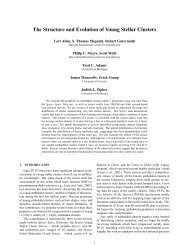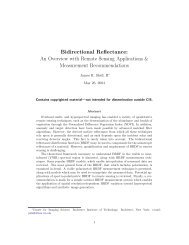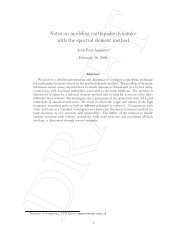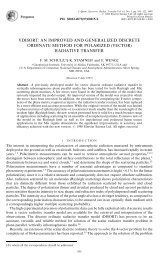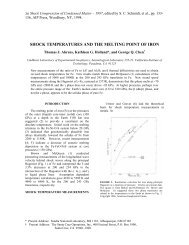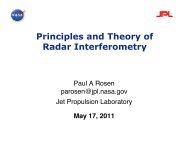VLIDORT User's Guide
VLIDORT User's Guide
VLIDORT User's Guide
Create successful ePaper yourself
Turn your PDF publications into a flip-book with our unique Google optimized e-Paper software.
given incident and reflected angles. With the use of the BRDF supplement, kernel input is notrequired for main <strong>VLIDORT</strong> calculations.The main subroutine (VBRDF_MAINMASTER) then carries out 3 tasks: (i) for the given choiceof BRDF kernels, the kernel BRDFs themselves are created for all angles and streams; (ii)Fourier components of the BRDF kernels are generated by integrating over azimuth from 0 to 2πwith a double Gaussian quadrature scheme; (iii) the total BRDF Fourier components are thencreated by a weighted combination of kernel components. The output from this subroutine is thenwritten to file for subsequent use in <strong>VLIDORT</strong> itself; it is also possible to combine the BRDFsupplement with the main <strong>VLIDORT</strong> call inside one environment, as has been done in2p6_brdfplus_tester.f90 and V2p6_brdfplus_tester.f90.For a calculation with surface property weighting functions, additional BRDF inputs are required.These are listed in Table C in the next section. One can obtain Jacobians with respect to thekernel amplitude factors and/or the non-linear characterizing parameters such as wind speed inthe glitter BRDF. Now, we use the file-read subroutine VBRDF_LIN_INPUTMASTER for allkernel inputs (regular and linearized), and the user environment will then call the subroutineVBRDF_LIN_MAINMASTER which will deliver the total BRDF Fourier components for all therequired geometrical configurations, as well as the linearizations of these total BRDF Fouriercomponents with respect to a number of BRDF properties.The total number of surface weighting functions (N_SURFACE_WFS) encompasses both theamplitude factor and the non-linear characterizing parameter Jacobians. The Jacobian property isordered by kernels, with the amplitude factor followed by the non-linear parameters for eachkernel in succession. For example, if we have a 3-kernel Lambertian, Ross-thin, Li-Sparsecombination in that order, then we can define 5 possible surface weighting functions: (1)amplitude for the Lambertian albedo (kernel #1), (2) amplitude for the Ross-thin (kernel #2), (3)amplitude for the Li-sparse (kernel #3), (4) non-linear parameter #1 for the Li-sparse, and (5)non-linear parameter #2 for the Li-sparse.Note. This kernel bookkeeping applies only to the BRDF supplement. The main <strong>VLIDORT</strong>calculation has no knowledge of individual kernels or the order or type of surface propertyJacobians. <strong>VLIDORT</strong> calculations only deal with the total BRDFs and their derivatives withrespect to a set number of surface properties.Note. The BRDF supplement is not required for a pure Lambertian surface calculation in<strong>VLIDORT</strong>; it is only necessary then to set the flag DO_LAMBERTIAN_ALBEDO and specifythe albedo itself (LAMBERTIAN_ALBEDO in section 6.1.1.1 Table A7). Lambertian albedoweighting functions do not require any additional information.6.3.3. BRDF inputs and outputsThis section contains tables regarding (1) BRDF supplement input and output type structures and(2) file-read character strings found in the input configuration file VBRDF_ReadInput.cfg.107



